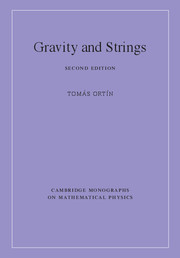Book contents
- Frontmatter
- Dedication
- Contents
- Preface to the second edition
- Preface to the first edition
- Part I Introduction to gravity and supergravity
- Part II Gravitating Point-Particles
- 11 The Schwarzschild Black Hole
- 12 The Reissner–Nordström black hole
- 13 The Taub–NUT solution
- 14 Gravitational pp-waves
- 15 The Kaluza–Klein black hole
- 16 Dilaton and dilaton/axion black holes
- 17 Unbroken supersymmetry I: supersymmetric vacua
- 18 Unbroken supersymmetry II: partially supersymmetric solutions
- 19 Supersymmetric black holes from supergravity
- Part III Gravitating extended objects of string theory
- Appendix A Lie groups, symmetric spaces, and Yang–Mills fields
- Appendix B The irreducible, non-symmetric Riemannian spaces of special holonomy
- Appendix C Miscellanea on the symplectic group
- Appendix D Gamma matrices and spinors
- Appendix E Kähler geometry
- Appendix F Special Kähler geometry
- Appendix G Quaternionic-Kähler geometry
- Appendix H Real special geometry
- Appendix I The generic scalar manifolds of N ≥ 2, d = 4 SUEGRAs
- Appendix J Gauging isometries of non-linear σ-models
- Appendix K n-spheres
- Appendix L Palatini's identity
- Appendix M Conformal rescalings
- Appendix N Connections and curvature components
- Appendix O The harmonic operator on ℝ3 × S1
- References
- Index
18 - Unbroken supersymmetry II: partially supersymmetric solutions
from Part II - Gravitating Point-Particles
Published online by Cambridge University Press: 05 April 2015
- Frontmatter
- Dedication
- Contents
- Preface to the second edition
- Preface to the first edition
- Part I Introduction to gravity and supergravity
- Part II Gravitating Point-Particles
- 11 The Schwarzschild Black Hole
- 12 The Reissner–Nordström black hole
- 13 The Taub–NUT solution
- 14 Gravitational pp-waves
- 15 The Kaluza–Klein black hole
- 16 Dilaton and dilaton/axion black holes
- 17 Unbroken supersymmetry I: supersymmetric vacua
- 18 Unbroken supersymmetry II: partially supersymmetric solutions
- 19 Supersymmetric black holes from supergravity
- Part III Gravitating extended objects of string theory
- Appendix A Lie groups, symmetric spaces, and Yang–Mills fields
- Appendix B The irreducible, non-symmetric Riemannian spaces of special holonomy
- Appendix C Miscellanea on the symplectic group
- Appendix D Gamma matrices and spinors
- Appendix E Kähler geometry
- Appendix F Special Kähler geometry
- Appendix G Quaternionic-Kähler geometry
- Appendix H Real special geometry
- Appendix I The generic scalar manifolds of N ≥ 2, d = 4 SUEGRAs
- Appendix J Gauging isometries of non-linear σ-models
- Appendix K n-spheres
- Appendix L Palatini's identity
- Appendix M Conformal rescalings
- Appendix N Connections and curvature components
- Appendix O The harmonic operator on ℝ3 × S1
- References
- Index
Summary
Now that we have studied maximally supersymmetric vacua, we are ready to study solutions with fewer unbroken supersymmetries. We are particularly interested in solutions that tend asymptotically to a maximally supersymmetric solution because we can assign to them conserved charges and supercharges: as explained in Section 10.1.2, spacetimes (supersymmetric or not) with these asymptotics have well-defined conserved bosonic charges associated with the isometries of the vacua they approach asymptotically, but it is also possible to assign to them supercharges using the same formalism [1]. Then, it is possible (at least formally) to associate with these solutions states in the quantum theory transforming under the vacuum supersymmetry algebra, with well-defined quantum numbers associated with all the generators. The supersymmetry algebra satisfied by the unbroken bosonic symmetries and supersymmetries of the vacuum can then be used to find relations that have to be obeyed by the charges and supercharges of the solutions with partially unbroken supersymmetry and that imply bounds for certain functions of the charges of non-supersymmetric solutions under certain assumptions.
We will study these properties in Section 18.1, considering the solutions with partially unbroken supersymmetry not as vacua but as excitations of some vacuum to which they tend asymptotically. By associating states in a quantum theory with these solutions and using the vacuum superalgebra, general supersymmetry bounds for the mass can be derived. These bounds are saturated by (supersymmetric or “BPS”) states with partially unbroken supersymmetry. The bounds can be extended to solutions of the theory, even in the absence of supersymmetry, if certain conditions on the energy–momentum tensor are imposed. These are very powerful techniques.
For these and other reasons, the solutions with partially unbroken supersymmetry (to which we will refer as supersymmetric or BPS in what follows) are very interesting, which raises the question of how to find them. One can always test the supersymmetry of a solution by checking whether or not it admits Killing spinors but it is desirable to have more general characterizations or classifications.
- Type
- Chapter
- Information
- Gravity and Strings , pp. 512 - 561Publisher: Cambridge University PressPrint publication year: 2015



